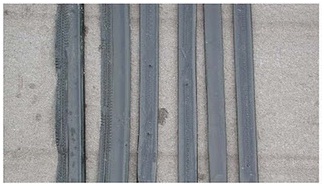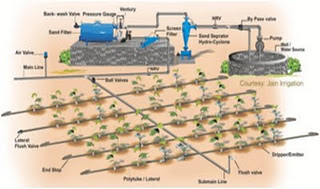Drip Irrigation
Published on Feb 14, 2016
Abstract
Drip irrigation,also known as trickle irrigation or microirrigation is one of the sub-surface irrigation method of applying water or frequent application of water to crops through small emitters in the vicinity of the root zone, wetting a limited amount of surface area and depth of soil. The theory behind drip irrigation is to apply sufficient moisture to the root of the crops to prevent water stress.
A major difference between drip system and most other systems is that the balance between crop evapotranspiration and applied water is maintained over limited periods of 24 to 72 hours. The conversion from sprinkler to drip irrigation can result in water use reduction of 50% and double yield. This is a result of improved water use and fertility and reduced disease and weed pressure.
Need Of Drip Irrigation
Drip irrigation can help you use water efficiently.A well-designed drip irrigation system loses practically no water to runoff, deep percolation, or evaporation. Drip irrigation reduces water contact with crop leaves, stems, and fruit. Thus conditions may be less favorable for the onset of diseases. Irrigation scheduling can be managed precisely to meet crop demands, holding the promise of increased yield and quality.Growers and irrigation professionals often refer to "subsurface drip irrigation,"or SDI. When a drip tape or tube is buried below the soil surface, it is less vulnerable to damage during cultivation or weeding.
With SDI, water use efficiency is maximized because there is even less evaporation or runoff.Agricultural chemicals can be applied more efficiently with drip irrigation. Since only the crop root zone is irrigated, nitrogen already in the soil is less subject to leaching losses, and applied fertilizer N can be used more efficiently. In the case of insecticides, less product might be needed.
Components And Working
In drip irrigation, also known as trickle irrigation, water is applied in the form of drops directly near the base of the plant. Water is conveyed through a system of flexible pipelines, operating at low pressure, and is applied to the plants through drip nozzles. This technique is also known as 'feeding bottle' technique where by the soil is maintained in the most congenital form by keeping the soil-water-air proportions in the optimum range. Drip irrigation limits the water supplied for consumptive use of the plant by maintaining minimum soil moisture, equal to the field capacity, thereby maximizing the saving. The system permits the fine control on the application of moisture and nutrients at stated frequencies.
DISTRIBUTION SYSTEM
The role of the distribution system is to convey the water from the source to the field. Distribution systems may be above ground (easily movable) or underground (less likely to be damaged).Pipes are most commonly made of PVC or polyethylene plastics.Aluminum pipes are also available, but are more difficult to customize, cut, and repair.The size and shape of the distribution system may vary widely from field to field and from farm to farm.
2.4 DRIP TAPE (OR DRIP TUBE)
The drip-irrigation system delivers water to each plant through a thin polyethylene tape (or tube) with regularly spaced small holes (called emitters). Selection of drip tape should be based on emitter spacing and flow rate. The typical emitter spacing for vegetables is 12 inches, but 8 inches or 4 inches may be acceptable. Dry sections of soil may develop between consecutive emitters when a wider emitter spacing (18 inches) is used on sandy soils. Flow rates are classified into low flow (<20gal/100ft/hr), medium flow (20 to 30 gal/100ft/hr) and high flow(>30 gal/100ft/hr). The risk of emitter clogging is generally higher with the lower-flow drip tapes.In the field, drip-irrigation tape should be installed with emitters upward (looking up) to prevent clogging from sediment deposits settling in the emitters between irrigation events. Drip tapes are widely available from several manufacturers.

Fig 2.4 Drip Tapes (Credits:Eric Simonne)
2.5 INJECTORS
Injectors allow the introduction of fertilizer, chemicals and maintenance products into the irrigation system. Florida law requires the use of an anti-siphoning device (also called backflow-prevention device) when fertilizer, chemicals or any other products are injected into a drip-irrigation system.Backflow-prevention devices ensure the water always moves from the water source to the field. The devices prevent chemicals in the water from polluting the water source. The most common injectors used with smalldrip-irrigation systems are the Venturi (or Mazzei) injector and the Dosatron.Because Venturi injectors involve no moving parts and are less expensive, they are commonly used on small farms. The injector is typically located as close as possible to the irrigation zone, but before the filter.
FILTRATION SYSTEM
Because drip-irrigation water must pass through the emitters, the size of the particles in the water must be smaller than the size of the emitter to prevent clogging. Nearly all manufacturers of drip-irrigation equipment recommend that filters be used. The filtration system removes "large" solid particles in suspension in the water. Different types of filters are used based on the type of particles in the water. Media filters (often containing angular sand) are used with surface water when large amounts of organic matter (live or dead) need to be filtered out. Screen filters or disk filters may be used withgroundwater. A 200-mesh screen or equivalent is considered adequate for drip irrigation.When the water contains sand, a sand separator should be used.
Rapid clogging may occur when no filter or the incorrect type of filter is used. A filter needs to be cleaned when the difference in pressure across the R filter (measured before and after the filter) is greater than 5 - 8 psi. A drip-irrigation system should never be operated without a filter even if the filter requires clogged drip-tape emitters, often resulting in poor uniformity and sometimes in crop loss. The filter should be cleaned as often as needed. Efforts should be made to understand the cause of the rapid clogging, and remediation for the problem should bdeveloped. The presence of the filter after the point of fertilizer injection means totally soluble fertilizers must be used. Otherwise fertilizer particles may contribute to filter clogging.
The whole field is divided into suitable plots. A secondary line is provided for each such plot, and a number of trickle lines are connected to each secondary line. A discharge regulator is provided at the beginning of each secondary line, and its capacity is fixed in accordance with the size and the number of nozzles used. The automatic valve at the head is so adjusted to deliver the desired quantity of water and the irrigation terminates automatically after this amount is discharged
